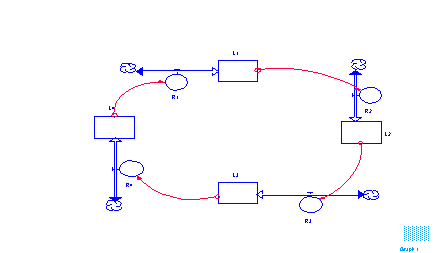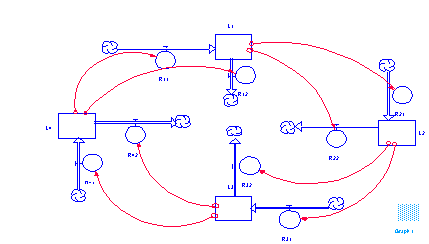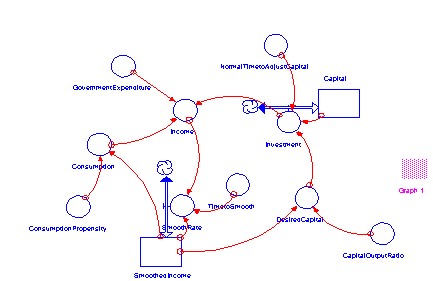Study on Dynamic System Behavior and Comparison
of Dominant Loop Analysis Approaches
Yi-ming Tu Associate Professor
Department of Management Information System
Chia-ping Chen Doctoral Student
Ya-tsai Tseng Doctoral Student
Department of Business Management
National Sun Yat-sen University, Kaohsiung, Taiwan, R.O.C
Abstract
Previous researches have shown that dominant loop analysis is
helpful in analyzing the relationships between dynamic system
behaviors and close loop structure. Before applying dominant loop
analysis methodology, we have to understand the basic loop behaviors.
This research first clarified the basic loop behaviors by developing
the perspective of implicit loops. Then we concentrated on some
basic concepts in using dominant loop analysis, such as the meaning
of system behavior and the conditions of dominant loop shift.
Using the concepts clarified and developed earlier, we tried to
give an explanation of the different analysis results by two different
dominant loop analysis approaches developed by Kim and by Richardson.
In summary, we hope to enhance the theory basis of System Dynamics
by clarifying the basic concepts of system structures and system
behaviors.
1. Introduction
The philosophy of System Dynamics lies on the endogenous point
of view treating system behavior as generated by the close feedback
loop structures. Feedback loops have been regarded as the key
point to understand complex systems. Accordingly, the basic behaviors
of element loop structures and the interrelations of multiple
feedback loops are the main concerns of system dynamics researches.
However, as to the behaviors of basic loops, scholars have not
thoroughly accepted that one single positive loop generates the
exponential growth or decay behavior and a negative loop generates
the goal seeking behavior. There are some anomalous examples that
leave some unsolved confusions to scholars(Graham, 1973;Richardson,
1995). In analyzing the relationships between system behaviors
and loop structures, although many studies have provided valuable
methodologies on the dominant loop analysis(Richardson, 1995;Kim,
1995), some basic concepts of dominant loop shift have not been
well-defined, such as the conditions of dominant loop shift. Perspective
of implicit loops is proposed to explain the confusions about
basic loop behaviors, and the "nonlinearity" of feedback
loops under which dominant loops may shift is discussed to enhance
our understanding about dominant loop analysis. Finally, we applied
two dominant loop analysis approaches developed by Richardson
and by Kim to illustrate the concepts clarified in this paper.
2. Basic Loop Behavior and the Perspective of implicit loop
To system dynamists, it is well known that a positive loop generates
exponential growth or decay and a negative loop corresponds to
a goal seeking behavior(Forrester, 1968). Researchers found that
this traditionally accepted rule may not always work well. Graham
described that in certain conditions positive loop may generate
oscillation patterns(Graham, 1973) , and Richardson suggested
that a single negative loop may also create oscillation(Richardson,
1995). There seems to be some controversies on the basic loop
structure behaviors. As to these controversies, Richardson proposed
the concept of implicit loops or pathways to explain how changes
in the behavior of a variable of the system occur over time(Richardson,
1995). To extend the concept of implicit loops, this research
suggested that the presentation of structure diagrams is the primary
reason contributing to confusion about the basic loop behaviors.
In modeling, researchers use flow diagrams as their tool to represent
the structures of systems. Whatever computer applications people
may use, the common characteristics of these applications are
that they all offer the function of bi-flow rates and they all
allow the levels to be negative. These two properties structure
diagrams together contribute to the implicit loops which might
confuse people with the behaviors of pure positive loops and pure
negative loops. To illustrate, figure 1 is the structure diagram
which scholars have controversies on the positive loop behavior(Graham,
1973) and figure 2 is the simulation result.

Figure 1 Illustration of Implicit Loop (source:Graham,A.K.
"Priciples on the Relationship Between Structures and Behavior
of Dynamics Systems", Ph.D. Dissertation, M.I.T., Cambridge,
1973.)
Figure 2 Behavior of Figure 1

Figure 3 Implicit loop of Figure 1
From the result, we can see obviously that there is only 1 positive
loop. With the bi-flow rates and negative levels, figure 1 can
be expressed in such a way like figure 3, which contains 8 positive
loops and 8 negative loops. These implicit loops come from different
combinations of negative or positive levels and inflow or outflow
rates.
The concept of implicit loops is very simple. But it gives us
some information in model building. First, it articulates the
basic loop behavior that is the theory foundation of system dynamics.
Second, it reminds us that some problems may occur when modeling.
The purpose of model building is to find out the problem structure.
The model structure has to be as similar to the real world as
possible. Bi-direction flows may be the actual property of some
real world case. No matter what kind of presentation model builder
may choose, he or she has to be cautious with the gap between
the real world and the model presentation. The controversies about
basic loop behaviors and the existence of implicit loop are just
examples of the gap occurred when modeling.
3. Concepts of Dominant Loop Shift
Prior researches have focused on different approaches to characterize
behavior and to define principal structure. Nonlinear systems
can endogenously generate bifurcation and chaotic behaviors. However,
nonlinear may not be a necessary condition for dominant loop shift.
To discuss whether nonolinearity is the necessary condition for
dominant loop shift of system behaviors, we first clarify what
system behavior means and then we examine what the role nonlinearity
plays in dominant loop shift.
When referring to system behavior, one shall mean a particular
pattern at a specific time period of the concerned variable. The
key concept here is that system behavior is attached with one
variable, not the intangible overall system behavior. The behavior
of a system is observable only through the patterns of its components,
such as levels, rates, or other variables. With different variables,
the so called system behavior should be different and the dominant
loop of each pattern at each time period should not be all the
same.
In system dynamics, nonlinearity often means high order differential
equations to be nonlinear. In this sense, some researchers suggest
that nonlinearity is the necessary condition for dominant loop
shift. However we found that under some circumstances, linearity
differential equations may also have dominant loop shift. To have
the necessary condition for dominant loop shift, the term nonlinearity
should mean the relationship between one level and its net rate.
Only when the relationship between the level and its net rate
to be nonlinear should the dominant loop shift occur.
Up to now, we have concentrated on the basic concepts in system
dynamics and in dominant loop shift. Next, we shall apply these
concepts in explaining the result of two dominant loop analysis
approaches.
4. Comparison of Two Dominant Loop Analysis Approaches
The two dominant loop analysis approaches we illustrate here are
proposed by Richardson and by Kim(Richardson, 1995;Kim, 1995).
The former approach defined the dominant loop by the relationship
between one level and its net rate; the latter developed an algorithm
of loop gain to find out the dominant loop with maximum loop gain.
This research applied these two approaches in several models.
The experiment result showed that using different approaches different
dominant loops were found. For example, figure 4 is the Multiplier-Accelerator
Model by Gilbert(Randers,1980), and here we focused on level Capital.

Figure 4 Multiplier-Accelerator Model (sourece:Randers, J.
Elements of the System Dynamics Method, Cambridge, Mass:M.I.T.
Press, 1980)
First, we calculated the loop gain developed by Kim and found
level Capital was dominated by a negative loop throughout simulation
period. To probe the phenomenon, we found that there might be
a problem with the algorithm of loop gain. In calculating loop
gain, the algorithm isolated concurrent system variation, thus
the loop gain acquired was not exactly consistent with the actual
loop gain. Second, we plotted the level-rate diagram to apply
Richardson's mean, the polarity of its dominant loop changed iteratively.
However, from the traditional point of view, the structure diagram
showed that there was only one loop around level Capital. It is
an obvious example of implicit loop we referred earlier.
5. Conclusion
In this research, we focused on some concepts of dominant loop
analysis methodology. First, the basic positive and negative loop
behaviors were clarified more clearly. Second, nonlinearity was
discussed to see if it is a necessary condition for dominant loop
shift. Finally, two dominant loop analysis approaches were applied
and the different analysis results were explained. From this paper,
we can see that dominant loop analysis is still an undeveloped
ground for researchers to explore.
References:
1.Forrester, J.W. Priciples of Systems, Cambridege, Mass:The
M.I.T.Press, 1968.
2.Graham,A.K."Priciples on the Relationship Between Structures
and Behavior of Dynamics Systems", Ph.D. Dissertation, M.I.T.,
Cambridge, 1973.
3.Kim, D.H."A New Approach for Finding Dominant Feedback
Loop:Loop by Loop Simulations for Tracking Feedback Loop Gains",
Proceedings of the 1995 International System Dynamics Conference,
vol2, p.601-610, 1995.
4.Randers, J. Elements of the System Dynamics Method, Cambridge,
Mass:M.I.T. Press, 1980.
5.Richardson, G.P., "Dominant Structure", System
Dynamics Review, vol. 2, no. 1, p.68-75, 1986.
6.Richardson, G.P., "Loop Polarity, Loop Dominance, and the
Concept of Dominant Polarity(1984)", System Dynamics Review,
vol.11, no. 1, p.67-88, 1995.
ISDC '97 CD Sponsor 



